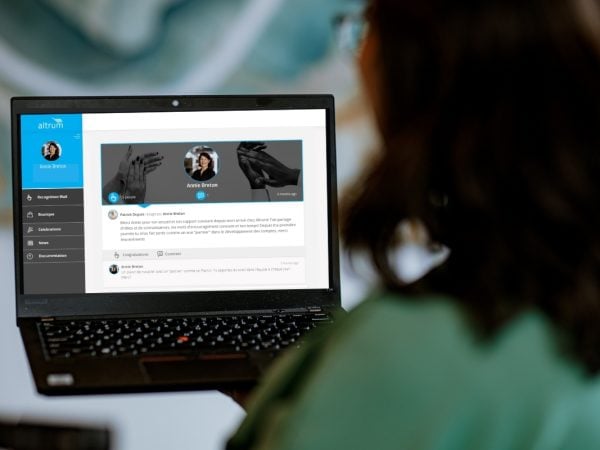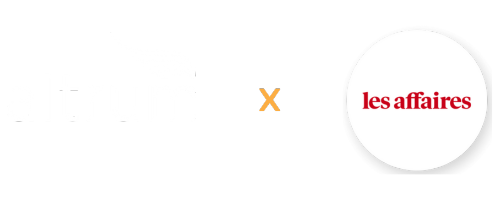Build a Culture of Recognition in the Workplace
May 30, 2024, In Employee Engagement
Creating a Culture of Recognition in the Workplace: Insights and Innovations
Last month, our colleague Annie Breton, Senior Account Executive at Altrum, was interviewed by Les affaires. She discussed everything related to recognition, as well as our cutting-edge peer recognition and rewards software. Keep reading to discover innovative employee recognition initiatives to boost motivation and engagement, and to learn more about Altrum’s comprehensive approach to creating a positive work environment.
In the professional world, employee recognition often boils down to celebrating service anniversaries or retirement departures. However, there are other innovative initiatives worth exploring to enhance employee motivation and increase engagement. According to Altrum, a company specializing in recognition solutions since 1957, a comprehensive approach is essential for achieving tangible results.
Gallup reports that lack of recognition is one of the most common reasons employees leave an organization. “More and more companies are keen to attract and, more importantly, retain their employees. To achieve this goal, they invest in developing an inspiring culture by choosing relevant values and creating a recognition policy that aligns with them. This last clearly defines the objectives, criteria, processes, and evaluation mechanisms for recognition while promoting transparency, fairness, and employee engagement. Ideally, a recognition policy should encompass formal, informal, and daily recognition. First, formal recognition highlights traditional milestones in an employee’s life cycle, such as years of service or retirements. Secondly, informal recognition is more spontaneous, for example, when a manager orders a lunch to celebrate a team success. Finally, daily recognition involves simple, regular gestures that can take various forms, such as acknowledging good deeds through a peer recognition software,” explains Annie Breton, Senior Account Executive at Altrum.
By integrating these three levels of recognition into a comprehensive policy, an organization can create a work environment where employees feel appreciated and motivated to give their best.
The Benefits of Highlighting Good Work
Why is it beneficial to highlight colleagues’ achievements? The data speaks for itself: companies with a peer recognition program are 35.7% more likely to achieve better financial results than those that limit recognition to managers and employees. This doesn’t even account for the numerous other benefits in terms of engagement, retention, and employee satisfaction. “It’s advantageous for several reasons. First, it’s proven that recognition makes employees happier. Who doesn’t like receiving praise? When someone receives a compliment and/or rewards at work, they feel valued, which fosters team cohesion and increases motivation to provide excellent service to customers, for example. A happy employee is also more likely to speak positively about their company. And if the company has job openings, the employee will be motivated to share the job postings. In summary, recognition increases the engagement level of team members, which is a significant advantage for businesses,” asserts Annie Breton.
A Peer Recognition Platform
According to an article, 44% of employees are more likely to recognize a colleague’s work if the company has a tool dedicated to this practice. In 2017, Altrum launched a bilingual peer recognition software for companies across various industries. This software creates a positive and supportive work environment and allows the sharing of achievements in real-time. You don’t need to be at your computer to recognize a colleague; you can do it from your mobile phone or tablet. This interactive software includes a reward points system, allowing points to be awarded for achievements, anniversaries (e.g., years of service or birthdays), reaching a goal, etc. These points can be exchanged for a range of customizable gifts such as gift cards and unique rewards (e.g., a day off, a donation, a contribution to an RRSP, branded items, and more).
“Recognition can be done in three ways: between colleagues, from manager to employee, and from employee to manager, as managers also need to feel valued! This is what we call 360-degree recognition, and it is essential for establishing a culture of recognition,” emphasizes Annie Breton.
Developing the Habit of Recognizing Good Work
Daily recognition is a motivational tool, but it’s essential to develop the right habits to use it effectively. “In 2017, Altrum launched the Orange Program, a 100% online training program for managers designed to raise awareness and develop the right habits,” reveals Ms. Breton.
Whether you are ready to take action or just want to discuss the peer recognition software and its benefits with an expert, learn more about Altrum’s solution. For advice, inspiring case studies, and the latest trends in workplace recognition, subscribe to their newsletter.










